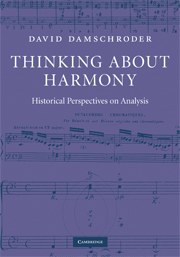Book contents
- Frontmatter
- Contents
- Preface
- 1 Chord identification
- 2 Chordal embellishment
- 3 Parallel and sequential progressions
- 4 Harmonic progression
- 5 Chordal hierarchy
- 6 Modulation to closely related keys
- 7 Chromatic chords: diminished/augmented
- 8 Chromatic chords: major and minor
- Epilogue
- Biographies of music theorists
- Notes and references
- Select bibliography of secondary literature
- Index
5 - Chordal hierarchy
Published online by Cambridge University Press: 02 November 2009
- Frontmatter
- Contents
- Preface
- 1 Chord identification
- 2 Chordal embellishment
- 3 Parallel and sequential progressions
- 4 Harmonic progression
- 5 Chordal hierarchy
- 6 Modulation to closely related keys
- 7 Chromatic chords: diminished/augmented
- 8 Chromatic chords: major and minor
- Epilogue
- Biographies of music theorists
- Notes and references
- Select bibliography of secondary literature
- Index
Summary
Passing note, passing chord
The third is a highly favored interval in chord construction. Consequently its diatonic filling-in – connecting root and third, third and fifth, or fifth and seventh – is encountered frequently. Any third may be expressed melodically as two consecutive seconds, either ascending or descending. The internal pitch of such a line clashes with its context: it “passes” between pitches that have a more secure footing within the immediate chordal framework.
A passing note occurs least obtrusively in a weak metrical position. Yet it may be emboldened in various ways. In filling in an F–D third, Friedrich Wilhelm Marpurg places passing note E in a relatively strong metrical position, against a change of bass from G to B [5.1a]. An eighth-eighth-quarter rhythm for F–E–D would have resulted in the juxtaposition, a consonant element of the G-B-D-F chord. Marpurg's quarter-eighth-eighth rhythm instead places bass B against passing E. As a result, a dissonant fourth follows a dissonant seventh. The interpretation of this situation is especially delicate because traditional dissonance-resolution strategy mandates that the F of a G chord should resolve to an E. Yet according to Marpurg it is not this E that fulfills that role, but instead the E on beat 3. The language he uses to express this idea in 1757 is clear and persuasive:
It is wrong to think that a dissonance could resolve properly on a passing note. That might at best happen only in a figurative sense.[…]
- Type
- Chapter
- Information
- Thinking about HarmonyHistorical Perspectives on Analysis, pp. 113 - 138Publisher: Cambridge University PressPrint publication year: 2008



